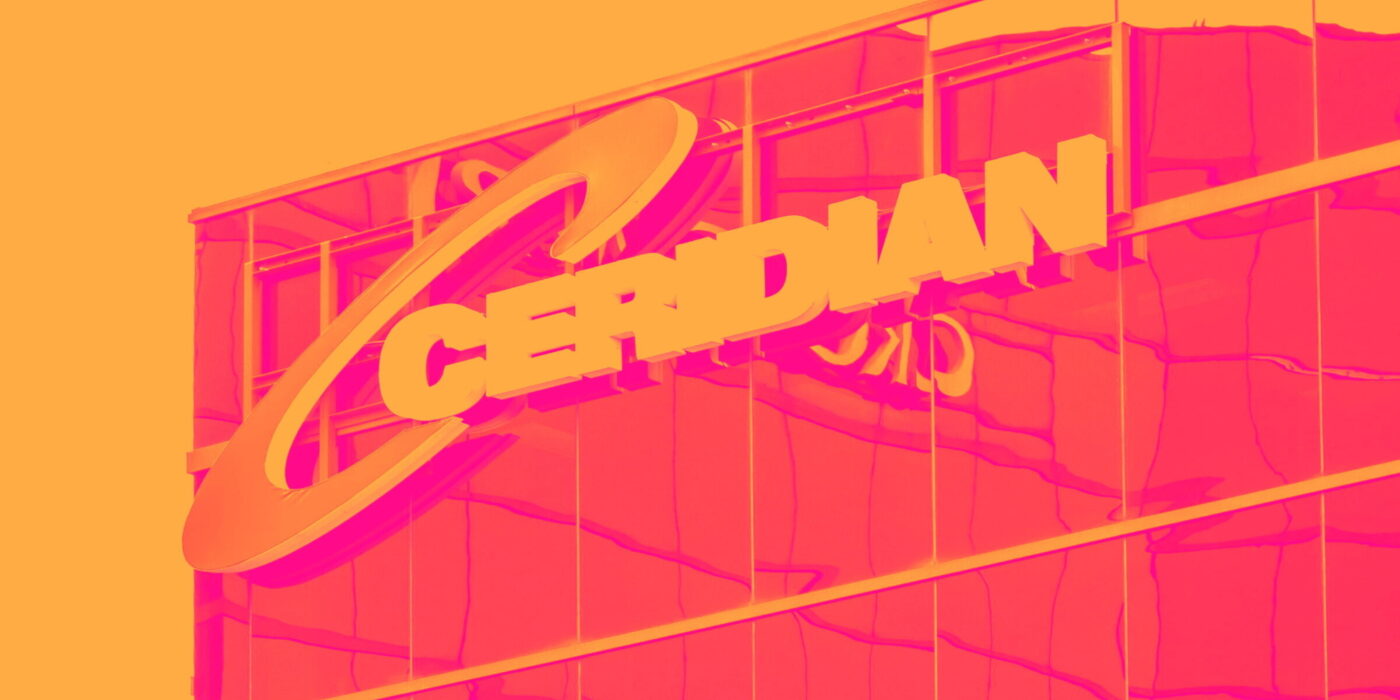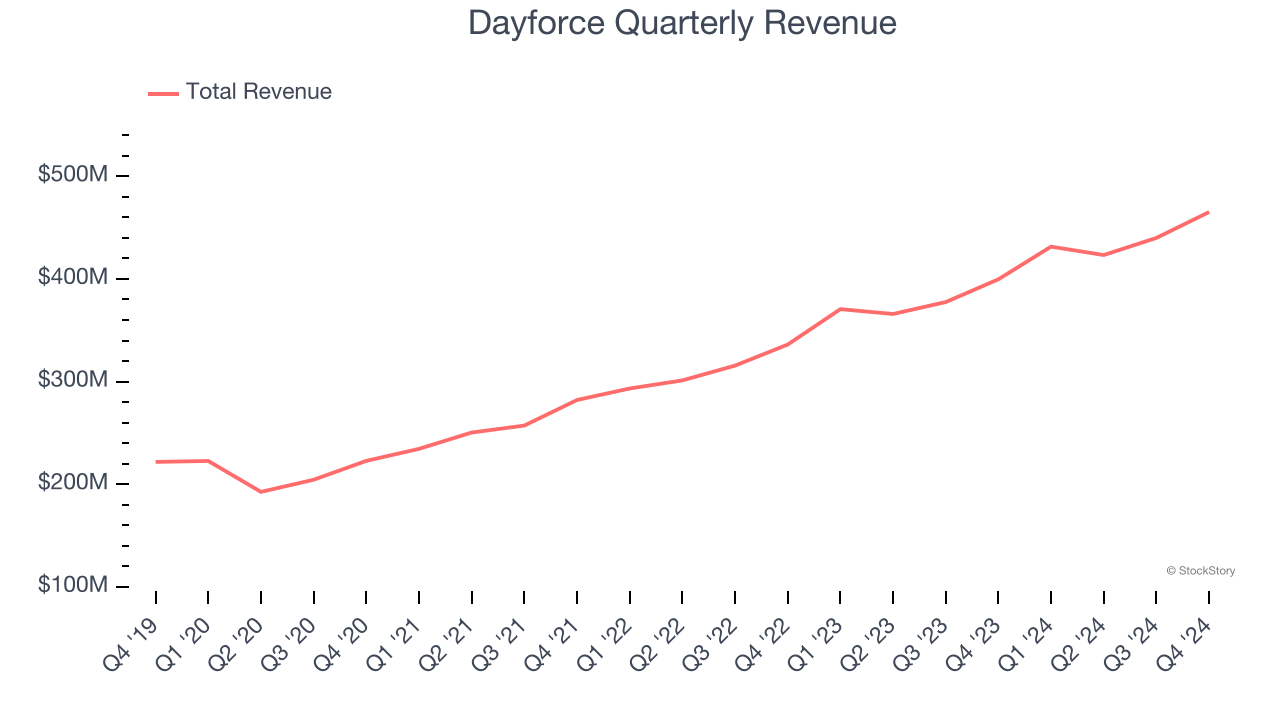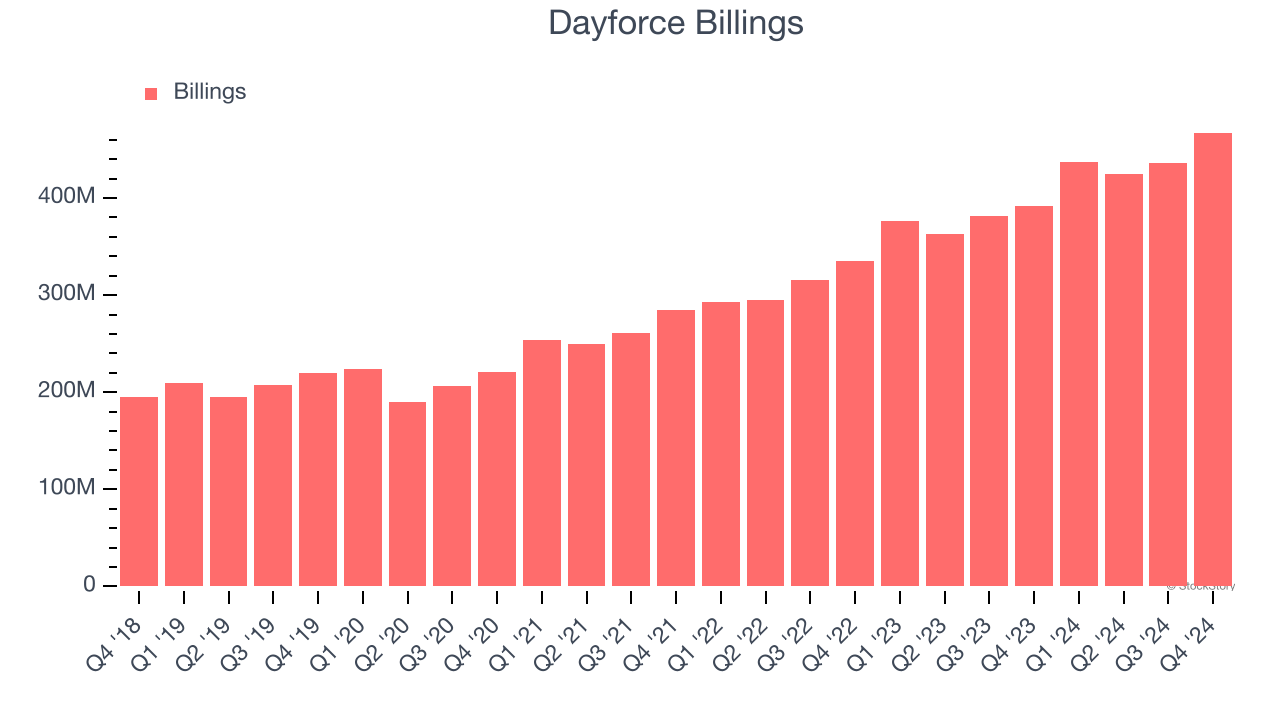
Online payroll and human resource software provider Dayforce (NYSE:DAY) reported revenue ahead of Wall Street’s expectations in Q4 CY2024, with sales up 16.4% year on year to $465.2 million. On the other hand, next quarter’s revenue guidance of $424 million was less impressive, coming in 11.9% below analysts’ estimates. Its non-GAAP profit of $0.60 per share was 34.8% above analysts’ consensus estimates.
Is now the time to buy Dayforce? Find out by accessing our full research report, it’s free.
Dayforce (DAY) Q4 CY2024 Highlights:
- Revenue: $465.2 million vs analyst estimates of $455.1 million (16.4% year-on-year growth, 2.2% beat)
- Adjusted EPS: $0.60 vs analyst estimates of $0.45 (34.8% beat)
- Adjusted EBITDA: $129.2 million vs analyst estimates of $128.8 million (27.8% margin, in line)
- Management’s revenue guidance for the upcoming financial year 2025 is $1.75 billion at the midpoint, missing analyst estimates by 10.6% and implying -0.4% growth (vs 16.3% in FY2024)
- Operating Margin: 6.1%, down from 9.7% in the same quarter last year
- Free Cash Flow Margin: 11.7%, down from 14.4% in the previous quarter
- Billings: $467.3 million at quarter end, up 19.2% year on year
- Market Capitalization: $11.31 billion
"2024 was a year of outstanding progress and innovation for Dayforce. We launched the Dayforce brand, maintained our product positioning as leaders in HCM, and drove significant innovation to help our customers achieve their best work,” said David Ossip, Chair and CEO of Dayforce.
Company Overview
Founded in 1992 as Ceridian, an outsourced payroll processor and transformed after the 2012 acquisition of Dayforce, Dayforce (NYSE:DAY) is a provider of cloud based payroll and HR software targeted at mid-sized businesses.
HR Software
Modern HR software has two powerful benefits: cost savings and ease of use. For cost savings, businesses large and small much prefer the flexibility of cloud-based, web-browser-delivered software paid for on a subscription basis rather than the hassle and complexity of purchasing and managing on-premise enterprise software. On the usability side, the consumerization of business software creates seamless experiences whereby multiple standalone processes like payroll processing and compliance are aggregated into a single, easy-to-use platform.
Sales Growth
A company’s long-term sales performance signals its overall quality. Even a bad business can shine for one or two quarters, but a top-tier one grows for years. Over the last three years, Dayforce grew its sales at a 19.8% annual rate. Although this growth is acceptable on an absolute basis, it fell slightly short of our benchmark for the software sector, which enjoys a number of secular tailwinds.

This quarter, Dayforce reported year-on-year revenue growth of 16.4%, and its $465.2 million of revenue exceeded Wall Street’s estimates by 2.2%. Company management is currently guiding for a 1.7% year-on-year decline in sales next quarter.
Looking further ahead, sell-side analysts expect revenue to grow 11.3% over the next 12 months, a deceleration versus the last three years. Despite the slowdown, this projection is above the sector average and indicates the market sees some success for its newer products and services.
Software is eating the world and there is virtually no industry left that has been untouched by it. That drives increasing demand for tools helping software developers do their jobs, whether it be monitoring critical cloud infrastructure, integrating audio and video functionality, or ensuring smooth content streaming. Click here to access a free report on our 3 favorite stocks to play this generational megatrend.
Billings
Billings is a non-GAAP metric that is often called “cash revenue” because it shows how much money the company has collected from customers in a certain period. This is different from revenue, which must be recognized in pieces over the length of a contract.
Dayforce’s billings punched in at $467.3 million in Q4, and over the last four quarters, its growth was solid as it averaged 16.6% year-on-year increases. This performance aligned with its total sales growth, indicating robust customer demand. The cash collected from customers also enhances liquidity and provides a solid foundation for future investments and growth. 
Customer Acquisition Efficiency
The customer acquisition cost (CAC) payback period represents the months required to recover the cost of acquiring a new customer. Essentially, it’s the break-even point for sales and marketing investments. A shorter CAC payback period is ideal, as it implies better returns on investment and business scalability.
Dayforce is extremely efficient at acquiring new customers, and its CAC payback period checked in at 9.4 months this quarter. The company’s rapid recovery of its customer acquisition costs indicates it has a highly differentiated product offering and a strong brand reputation. These dynamics give Dayforce more resources to pursue new product initiatives while maintaining the flexibility to increase its sales and marketing investments.
Key Takeaways from Dayforce’s Q4 Results
We enjoyed seeing Dayforce exceed analysts’ revenue, billings, and EPS expectations this quarter. On the other hand, its full-year revenue guidance fell short of Wall Street’s estimates and suggests a significant slowdown in demand. Overall, this quarter could have been better. The stock remained flat at $71.53 immediately after reporting.
Dayforce’s earnings report left more to be desired. Let’s look forward to see if this quarter has created an opportunity to buy the stock. The latest quarter does matter, but not nearly as much as longer-term fundamentals and valuation, when deciding if the stock is a buy. We cover that in our actionable full research report which you can read here, it’s free.
